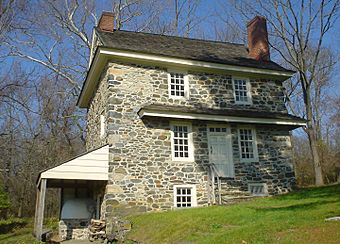John Chads House facts for kids
|
Chads House
|
|

Chads House, November 2009
|
|
| Location | PA 100, Chadds Ford, Pennsylvania |
|---|---|
| Area | 4 acres (1.6 ha) |
| Built | 1713 |
| Architect | Wyeth, John Jr. |
| Architectural style | "Bank" house |
| NRHP reference No. | 71000698 |
Quick facts for kids Significant dates |
|
| Added to NRHP | March 11, 1971 |
The Chads House is a very old and important house in Chadds Ford, Pennsylvania. It was built a long time ago for a man named John Chads. This house is special because it was added to the National Register of Historic Places in 1971. During a big battle called the Battle of Brandywine, John Chads' wife, Elizabeth, stayed in the house even though fighting was happening nearby! The town of Chadds Ford is even named after John Chads because of a spring and a river crossing on his land.
Contents
History of Chads House
The First Owners
The story of Chads House begins with Francis Chadsey. He came to Pennsylvania in 1685. In 1696, he bought 500 acres of land. This land is now part of Chadds Ford Township, Delaware County, Pennsylvania. Francis bought the land from Daniel Smith, who had bought it from William Penn.
Francis Chadsey took ownership of the land in 1702. He then built a grist mill and a special water channel called a millrace. He married Grace Stanfield in 1695. They had six children together. Francis passed away in 1713. Grace later remarried in 1714 and passed away in 1727.
Building the House
Francis Chadsey's oldest son, John Chads, became an adult in 1717. He then inherited the family property. The initials "J.W. Jr." are carved into the front of the house. This suggests that John Wyeth Jr. built the house. He likely built it for John Chads sometime between 1713 and 1727.
The Chads House is a "bank house." This means it was built into the side of a hill. This design helps keep the house cool in summer and warm in winter. The house still looks much like it did when it was first built.
A Busy Location
John Chads started a ferry service in 1731. This ferry helped people cross the Brandywine Creek. He ran the ferry until he passed away in 1760. The ferry continued to operate for many years. It stopped in 1828 when a bridge was built nearby.
The Battle of Brandywine
During the Battle of Brandywine in 1777, the Chads House was right in the middle of the action. General Wilhelm von Knyphausen's soldiers pretended to attack near the ferry. They exchanged cannon fire with George Washington's forces. Washington's troops were in strong positions above the house.
John Chads' widow, Elizabeth, stayed in the house during the entire battle. She watched the soldiers move from her attic windows. She lived until 1791, long after the battle.
From Home to Museum
Near the Chads House, there was a Springhouse. This building provided water for the property. It also served as a school for a few years, from 1837 to 1844.
Both the John Chads' House and the Springhouse were privately owned for a long time. In 1968, they were bought and carefully restored. An architect named John Milner helped with this work. The house then opened as a museum in 1971. The old beehive oven in the basement was rebuilt in 1981. It is still used today!
See also



